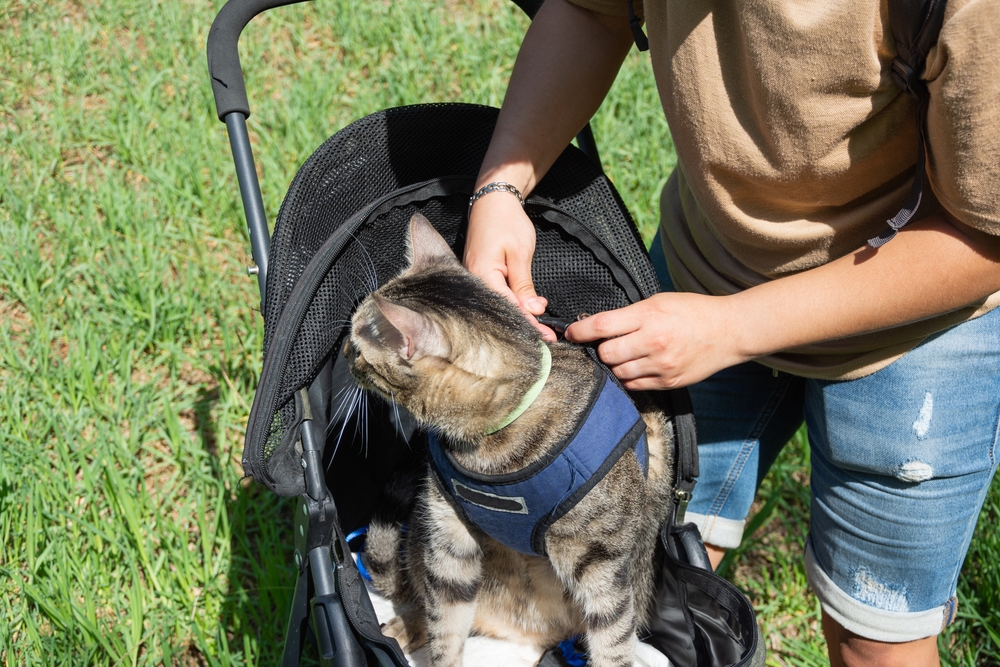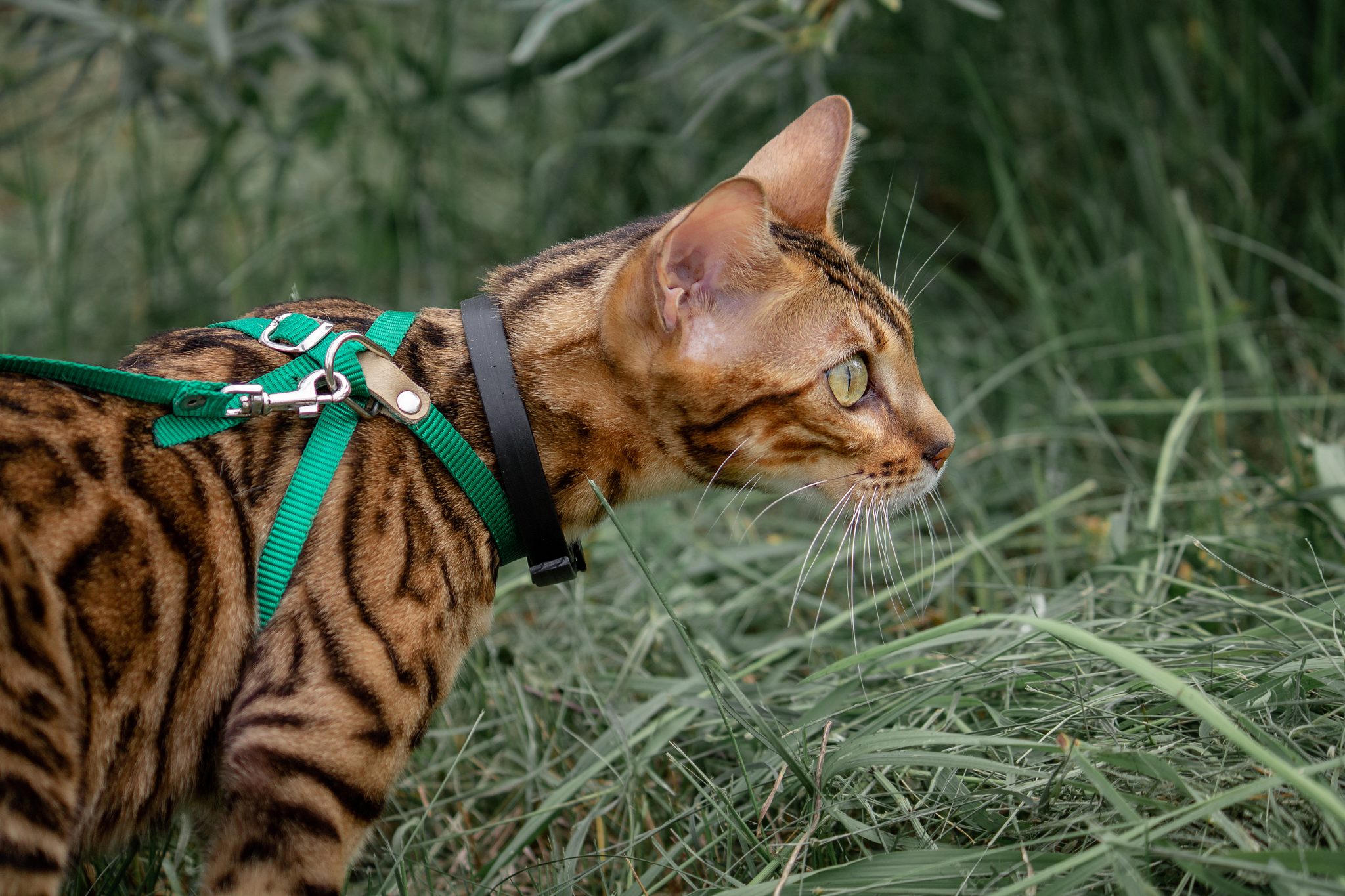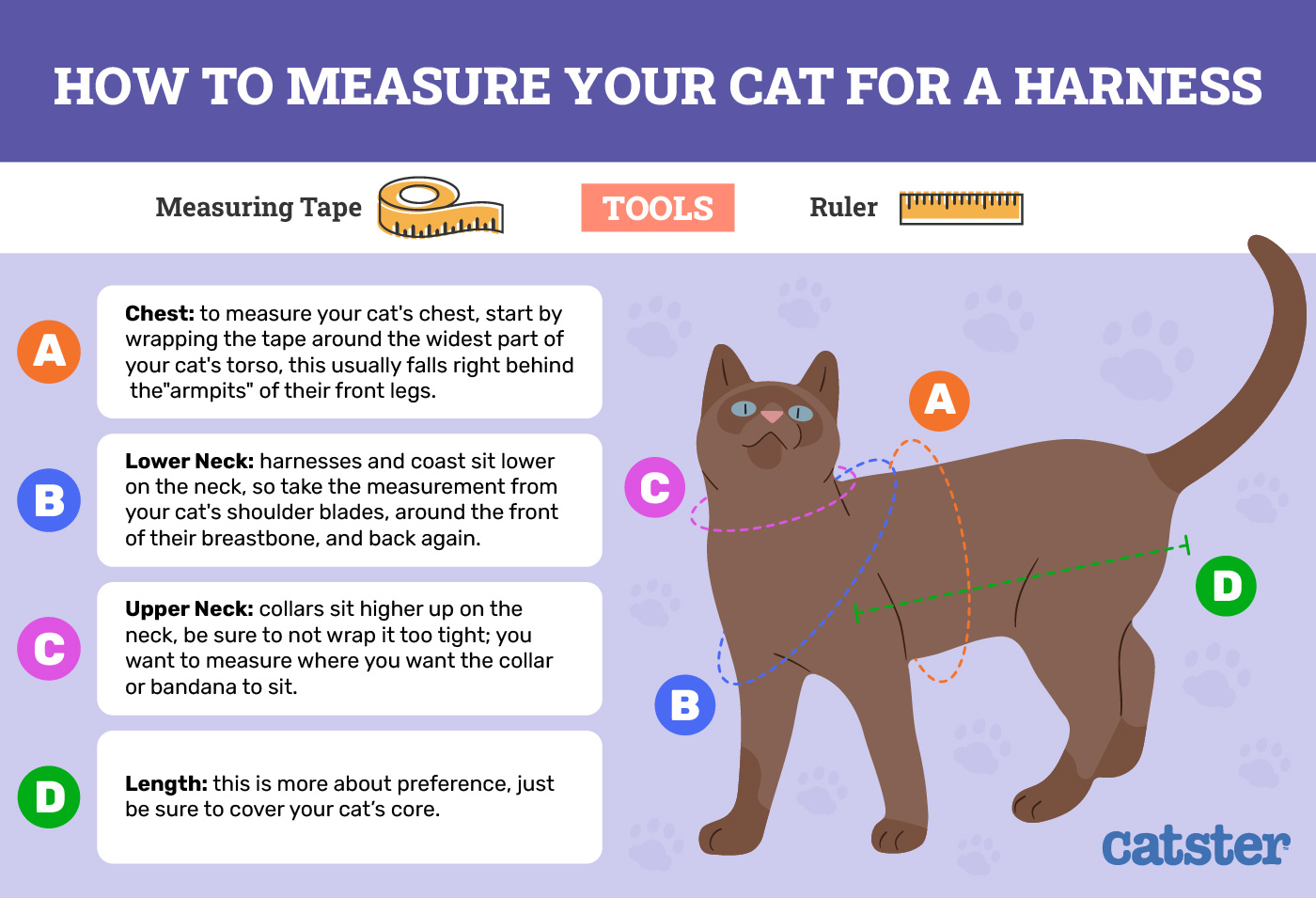As creatures of habit, cats do not like change. Something as simple as moving their litter box can cause them to become agitated and start acting out. Now imagine what it’s like to wear a harness, especially being pushed to walk while attached to a leash. Most cats will panic or at least, refuse to move.
This doesn’t mean you can’t train a cat to walk with a harness, however, because you certainly can, and it’s worth a try! Harness training is a great way to give your cat more freedom to explore the outside world.
But before the adventures begin, you need to spend time helping your cat get used to wearing it. Keep reading for 10 easy tips to do just that!


Our 10 Tips for Training Your Cat in a Harness
1. Introduce the Harness Slowly
We mean it slowly. Start by placing the harness near their favorite sleeping or play area, allowing them to explore and become familiar with it over a few days. This helps transform the harness from a foreign object to a familiar and non-threatening item in their environment.
For example, if your cat likes to sleep in a certain corner or has a favorite toy, place the harness near these locations. Over time, you may see your cat sniffing or even playing with the harness, indicating their curiosity and growing acceptance.

2. Reward and Praise Them
Positive reinforcement is key when helping your cat associate the harness with good things. Whenever they approach or investigate the harness, offer them treats and verbal praise.
Gradually increase the level of contact with the harness, such as holding it against your cat’s body or placing it on his back. Give them attention and a tasty morsel every time. It won’t take long for them to think harness = wonderful.
3. Practice Holding the Cat’s Body Using a Harness
Once your cat is desensitized to the presence of the harness, use it to touch different parts of his body, starting with the face, feet, and sides. Remember to pair touch with good food. Take your time! Do not rush to put the harness on until your cat is comfortable with you holding it. Next, try to increase the amount of time you touch different parts of their body, such as more than a few seconds, then move on to practicing putting on the harness.
4. Practice Wearing a Harness
For this part, choose a quiet place to keep your cat relaxed and comfortable. This is really the mindset you want, so they don’t fight the harness as you put it on.
Sit with them and let them sniff the harness again. Then gently put the harness on, constantly praising and offering treats throughout the process. Remove the harness after a few seconds and repeat this exercise for a few days to develop positive associations with the harness.

5. Keep Sessions Short
Avoid overwhelming your cat with long harness training sessions. Start with just a few minutes each day, and gradually increase the duration as they become more comfortable in the harness.
Always end training sessions on a positive note, whether it’s with a treat, pets, or a play session, to keep your cat interested and motivated.
6. Let Them Wear The Harness Inside
Once your cat tolerates the harness, have them wear it around the house for a short time.
Encourage your cat to engage in normal activities such as playing, eating, and sleeping with the harness on to further reinforce positive associations. The goal is to make the harness “invisible”, a normal part of their routine.
7. Attach the Tie
Once your cat is comfortable wearing the harness indoors, start attaching the leash. Avoid pulling or tugging—let them explore and move around while the leash pulls behind them. This helps them get used to the extra weight and length of the leash.
Only put the leash on for a few minutes at a time, with several practice sessions throughout the day. Stay at this stage for about a week.
Walking your cat may seem difficult, but the right harness and leash can make all the difference! We recommend Hepper’s Cat Harness and Leash Set because it combines important safety features with stylish and comfortable design elements.


Hepper Cat Harness and Leash Escape Proof Set -…
- Escape Proof – Cat leashes and harnesses for walking are not equally secure. Our double aluminum…
- Superior Comfort – Our cat harnesses are lightweight, made of premium velvet fabric, breathable…
- Free Extra Strength Leash – You don’t have to worry about your cat escaping with this harness. This cat…
From a highly adjustable, machine-washable velvet harness to a durable nylon climbing rope leash, this set has everything you need to start adventuring.
At Catster, we’ve admired Hepper for years and decided to take a controlling ownership interest so we can benefit from the unique designs of this cool cat company!
8. Practice Gentle Leash Control
Once your cat is comfortable wearing the harness and leash, you can start guiding them around the house. Handle the cord gently, avoid any pulling or forcing them in any direction.
Instead, use toys or treats to encourage your cat to move with you, helping them understand the concept of following your lead.
9. Transition to Outdoors
Begin taking your cat outside by starting in a quiet, enclosed outdoor space, such as the backyard or porch. Hold the leash, and let your cat explore at their own pace, offering treats and praise to make the experience enjoyable.

10. Gradually Increase Exposure
Over time, slowly introduce your cat to a busier outdoor environment. Stay close to them and keep the first outings short. Be patient and attentive to their needs, monitoring their language and body reactions. If they seem scared or stressed, go back inside and try again another day.
Again, don’t force them to stay on the leash longer than they want to. Doing so can undo all your hard work! Let your cat dictate the pace, and respect their limits.


How to Choose the Right Harness for Your Cat
Don’t have a harness yet, or your current one doesn’t fit? Follow these steps to choose the perfect one.
1. Measure Your Cat
An ill-fitting harness is not only uncomfortable for your cat. It’s also dangerous because if it’s too loose, they can escape the harness. If it is too tight, it can irritate their skin or cause injuries.
Don’t trust your best guess here! Get a tape measure for accuracy! Gently wrap it around your cat’s neck and chest, then record the measurements. Be sure to measure tightly but not too tightly. If your cat is afraid of the measuring tape, try using a soft tape, and then measure the tape.

2. Select the Harness Type
There are different types of harnesses you can buy: vest, H-style, and figure-eight. Your choice depends on what you plan to do with your cat.
For example, if your cat is an escape artist, an H-style harness with a figure-eight design will keep them from escaping. If you plan to take your cat on long walks or hikes, a vest harness with a padded chest plate can provide additional support and comfort.
3. Think about the Material
The material of the harness will affect your cat’s comfort and safety. For example, nylon and mesh are light and breathable, but leather is more durable.
4. Look for Safety Features
The more safety features your cat’s harness has, the better. Look for things like reflective material or bright colors that will make your cat more visible to drivers and pedestrians, especially at night.
A harness with a strong D-ring or buckle will prevent your cat from getting loose or escaping while walking. The velcro straps will make it easier to carry it on and off your cat, especially if yours is finicky.


Conclusion
Training your cat to wear a harness takes patience and work, but the results are worth it! Imagine taking your friend for a walk, for a walk along the neighborhood, or to the corner cafe so you two can relax outside. It can literally expand your cat’s world.
Before you start training them, however, be careful when choosing their harness. You want it to be comfortable, secure, and loaded with safety features. Don’t forget to buy tons of cat treats while you shop for their harness. You will need it!
Featured Image Credit: Laura Sanchez Ubellen, Shutterstock


